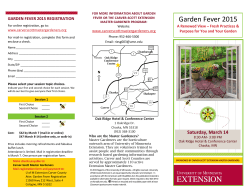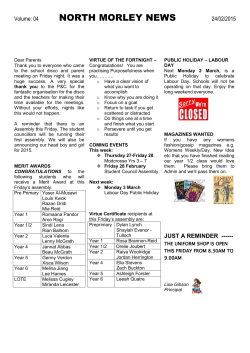
Winter 2015 - Utah State University Extension
Cache Gardeners News Cache County Master Gardeners are Utah State University trained volunteers whose mission is to help create a healthy environment in Cache County by educating and advising local residents about sustainable gardening practices. issue 1 V OL UME 1 W INT ER - 2 0 1 5 The Importance of Native Plants The Native Plant Society of Northeastern Ohio (same importance everywhere) As open space disappears, it becomes increasingly necessary to look at our own landscapes as a refuge for biodiversity. Native organisms including plants, mammals, birds, amphibians, and insects create an intricate web of life. This is a wonderful natural orchestration with each species’ life cycle highly dependent on the others. For example: Spring wild flowers are pollinated by and provide nectar to tiny flies. These flies become food for early spring birds. The timing is orchestrated perfectly. It is not a coincidence that the local native plants have seeds and berries ready just when the birds need them. Bird droppings are the best way to get their seed dispersed. Plants and animals that have evolved together depend upon each other for survival. Unfortunately, native plants, a vital part of the natural web of life, are being lost at an alarming rate. Removing a certain native plant from the landscape will likely remove the insect In This Issue..... that feeds on that plant, which in turn may eradicate Native Plants . . . . . . . . . . . . . 1 the bird that feeds on that insect. And this is just a Announcements . . . . . . . . . . .2 simplified example. Monarchs . . . . . . . . . . . . . . 3-4 The loss of a species can quickly escalate to affect Fun gardening ideas. . . . . . . . 5 an entire ecosystem. To paraphrase Paul Ehrlich, Recipes. . . . . . . . . . . . . . . . . 6 author of Native Plants: Relationship of Biodiversity to Pruning. . . . . . . . . . . . . . . . . 7 the Function of the Biosphere, removing native species from an ecosystem is like taking rivets out of an airplane wing; it is impossible to know which one will be the last (Continued on page 8) -1- Announcements and Classes . . NATIVE PLANT PROPAGATION WORKSHOP March 12 (Thursday), 6:00 p.m. — 9:00 p.m. March 14 (Saturday), 9:00 a.m. — noon Where: USU Teaching Greenhouse -1390 North 800 East, Logan Grow native plants from seeds and cuttings at this hands-on workshop. All materials will be supplied and you will leave with a planted seedling tray of about 60 potential plants. Learn water conservation strategies, get plans for an indoor lighting fixture to give your seedlings an early start. Master Gardeners & Utah Native Plant Society Members—$20.00, All Others—$25.00. Mother’s Day Plant Give-Away: May 9 (Saturday), 9 a.m. – 1 p.m. Where: Cache Valley Gardeners Market (location of market to follow) To do this we need plants. Please contact Tammy Rounds at tjstam@gmail.com or Candace Berthrong at cthrong@gmail.com if you can take on the task of growing plants for this event. Marigolds, asters, columbines, sunflowers, echinacea, most any type of salivas or penstemon, oregano or other herbs work well. If seeds are started soon they will be good size, maybe even flowering, by May 9th. THE CACHE VALLEY MEDIA GROUP 2015 HOME & GARDEN SHOW (20th year) March 27, 10 a.m. to 8 p.m. & March 28, 9 a.m. to 5 p.m. Where: The Eccles Ice Arena INVASIVE PESTS IN BACKYARD FRUIT TREES AND BERRIES ~Identifying Spotted Wing Drosophila & Brown Marmorated Stink Bug April 9 (Thursday), 6:00 p.m. Where: The Multipurpose Room Cache County Administration Building, 179 N. Main Street, Logan FRUIT TREE GRAFTING WORKSHOP April 17 (Friday): 3:00 - 5:00 p.m. Where: Willow Park Zoo Wildlife Learning Center 419 West 700 South, Logan Cost: $20.00 (class + 2 grafted fruit trees to take home) TOMATO GRAFTING WORKSHOP (REGISTRATION LIMITED!) April 21 (Tuesday): 6:00 p.m. Where: Willow Park Zoo Wildlife Learning Center 419 West 700 South, Logan Cost: $20.00 (class + 2 grafted tomato plants to take home) Please register for workshops by calling the USU Extension Office: 435-752-6263 -2- Six Ways to Save Monarchs from Wildlife Promise By David Mizejewski Monarch butterflies are in trouble. Over the last few decades, populations of these iconic orange and black butterflies have declined by over 90 percent. The National Widelife Federation is teaming up with the U.S. Fish and Wildlife Service and other partners to reverse this alarming trend and ensure that this beautiful butterfly has a future. The Problem Like all butterflies, monarchs lay their eggs on select plants, called “host plants.” These are the only plants their caterpillars can eat, and for monarchs, milkweed is their only host plant. Unfortunately, milkweed is becoming harder for monarchs to find. Despite being ecologically important and an often ornamental wildflower, many consider milkweed a weed to be eradicated, both in agricultural lands as well as in the urban and suburban landscape. As we’ve gotten better at wiping out milkweed, monarchs have suffered. Even when milkweed isn’t being targeted directly, monarch habitat in the United States is being gobbled up by development. Monarchs are also being directly killed by pesticides, both as caterpillars and as adult butterflies in farmlands and backyards. This, coupled with threats to the monarchs’ overwintering grounds in Mexico and California, has resulted in the precipitous decline of the insect’s population in North America. A monarch butterfly feeds on nectar from goldenrod in Rhode Island. Such late-blooming natives are critical for fueling the insects’ long migration to Mexico. Photo donated by National Wildlife Photo Contest entrant Bernadette Banville. Help Save Grasslands – America’s native grasslands are critically important for monarchs. They offer both milkweed for monarch caterpillars as well as nectar plants for adult butterflies (and many other pollinators too). Today, more than 90 percent of native grasslands have been converted to cropland and development. Grasslands are disappearing faster than any other ecosystem in North America, and that’s a big problem for monarchs. Join NWF in fighting to save grasslands for monarchs. Support Highway Habitat Corridor – NWF and USFWS are working to create a coalition of agriculture leaders and highway transportation organizations to plant milkweed and nectar plants along monarch migratory flyways and in other important monarch breeding grounds along key Midwest and Texas corridors. Learn more about highway habitat corridor plan and how to support it. Plant Milkweed – You can make saving the monarch personal by planting milkweed in your yard or garden. There are many milkweed species found in North America, so no matter where you live, there’s at least one species native to your area. You’ll be rewarded not only with he knowledge that you are making a difference, but by attracting monarchs to enjoy. Find out what milkweeds are from your region. (continued on next page) -3- -3- Don’t Use Pesticides – Monarchs are insects, and so spraying insecticides will kill them. Make the commitment to avoid spraying pesticides in your yard. Find out how to garden organically. Create Monarch Habitat– NWF’s Garden for Wildlife program can teach you how to turn any outdoor space into a complete habitat for monarch. Just provide food, water, cover and places to raise young. It all starts with what you plant and you can create a habitat garden in your own yard, at your office, your church or the local school grounds. Entire communities are launching efforts to create monarch habitat. Learn how to create a wildlife-friendly garden. Join NWF Affiliate Efforts in Your State — Eleven of NWF’s state affiliates are active partners in the Garden for Wildlife program, teaching people how to create habitat for monarchs and other wildlife. They offer regional expertise and resources, offering native milkweed seeds, running monarch tagging and citizen science efforts and even working on legislative solutions. Joining these efforts is a great way to get involved on the local level. Find out if your state’s NWF affiliate is working to protect monarchs. It’s Up to Us The loss of any species weakens the ecosystem that all species rely on for survival, including humans. Monarch butterfly decline is an indicator that there is something wrong in our shared environment and a warning that we could be affected as well. Do we really want to live in a world where the next generation has no chance of seeing a monarch butterfly on a flower? We are committed to reversing the decline of the monarch. NWF’s President Collin O’Mara has this to say: “I have a 3-year-old whose eyes pop wide open when she sees monarchs crawling on leaves in the backyard. This is one of those keystone species. These are things that don’t make headlines, but they are indicators that something bigger is happening.” Will you help us be part of the solution and make sure monarchs have a future? -4 Give Your Garden A Calcium Boost My blender rarely sees daylight, but now it might just get the chance to see the kitchen counter with this genius tip! I’m starting to understand the idea behind compost a little more now that I’m dabbling in the garden, so this just makes a lot of sense to me. Just like grinding your food makes it easier to digest, grinding eggshells makes it easy for your garden to absorb the calcium egg shells provide. Keep animals Keep petspets andand animals out of out of your garden your garden Grow rose bushes from trimmings with the help of potatoes Save the Rain Make your own rain out of a heavy duty trash can. -5- Molasses Horseradish Sweet Potato Spears Serves 8-10 • • • • • • 3 lbs medium sweet potatoes, peeled and cut lengthwise into 8 spears 1/4 cup vegetable oil (or olive) 1-1/4 teaspoon salt 5 tablespoons unsalted butter 1/3 cup molasses (not robust or blackstrap) 1/3 cut bottled horseradish (including juices; 3 oz.) •• Put rack in lower third of oven and preheat to 450° •• If spears are very long, halve diagonally. Toss potatoes with oil and 3/4 teaspoons salt in large bowl, spread/1 layer in a large shallow baking pan (light colored metal/non-stick OK; at least 1” deep). Roast, turning once or twice, until tender (18-22 minutes). Leave oven on •• While potatoes are roasting: bring butter, molasses, horseradish and remaining 1/2 teaspoon salt to a boil in a small, heavy saucepan, stirring, then reduce heat and simmer until slightly thickened (stir occasionally) and reduced to about 3/4 cup —about 5 minutes. •• Transfer mixture to a blender and puree 30 seconds (use caution with hot liquid). •• Pour glaze thru a fine-mesh sieve; press and then discard solids (or skip this step per your preference) •• Drizzle glaze over cooked sweet potatoes and gently toss until coated. •• Just before serving, bake glazed sweet potatoes in lower 3rd of oven until hot (3-5 minutes if start when potatoes are still warm (sweet potatoes can be roasted 2 hours ahead). Northwestern Salmon Chowder • • • • • • • • • • • • 1 cup each: chopped celery, onion (+), green pepper 1 clover (+) garlic-minced 3 tablespoons butter 1 can (14.5 oz.) chicken broth 1 cup uncooked potatoes, peeled and diced 1 cup shredded carrots (some shredded/some in wheels) 1-1/2 teaspoon salt 1/2 teaspoon pepper 1/4 to 3/4 t. dill weed 1 can (14.5 oz.) creamed corn (or frozen corn) 2 cups half and half cream 1-3/4 to 2 cups cooked salmon (or one can drained) •• In a large sauce pan, saute celery, onion, green pepper and garlic in butter until tender. •• Add broth, potatoes, salt, pepper and dill; bring to a boil. •• Reduce heat, cover and simmer for 40 minutes or until vegetables are nearly tender. Stir in corn, cream and salmon. Simmer for 15 minutes or until heated. •• Yields 2 quarts (8 servings) -6- Five Common Pruning Mistakes, and How to Fix Them from Fine Gardening There is nothing less noticeable than an excellent pruning job. But on the flip side, there is nothing more noticeable than a poorly pruned plant. Pruning is a science and an art. The science involves recognizing plant flaws and skillfully eliminating or minimizing these defects. The artistic end involves removing these bad parts or pieces with a disguised grace so that the plant appears unmarred and untouched. As gardeners, though, we sometimes forget about one of these aspects when pruning, and that’s when we make mistakes. A brief glossary of pruning terms Have you ever tried to read a book on pruning and felt like it was written in a foreign language? Don’t worry-you’re not alone. Here are some common terms to demystified: APICAL BUD The bud that produces new growth, typically located at the tip of a branch; also known as the dominant or terminal bud AUXIN A growth hormone found in apical buds that promotes cell division (new growth) and inhibits any lower buds from growing LATENT BUD Any bud-typically below the apical bud-that remains dormant or underdeveloped for a long time but may eventually grow LATERAL BRANCH Any branch or minor stem that grows off the leader LEADER The main or dominant stem of a plant MAIN SIDE BRANCH A large lateral branch that is usually only slightly smaller in diameter than the leader Everyone can relate to that feeling of panic after making a cut and realizing that you’ve just ruined the shape of your shrub. Or perhaps you’ve ignored a plant’s obvious structural problem because you were afraid or unsure of what pruning action to take. Improper pruning can lead not only to ugly plants but also to liability in the landscape. There is some recourse, thankfully, for these errors in pruning judgment. Here’s are links to the five pruning mistakes I see most often and advice on how to fix them to save your plants and your sanity. Pruning mistake #1 You keep snipping the tips of your plants to keep them in check. Pruning mistake #2 Your conifers are out of control in summer, so you cut back the longest branches. Pruning mistake #3 You shear your weeping cherry tree so that it looks like it has a Beatle haircut. Pruning mistake #4 The tree in the front yard is too tall, so you chop off the top to make it stop growing up. Pruning mistake #5 You decide not to prune. For more information visit www.finegardening.com/five-common-pruning-mistakes-and-how-fix-them#ixzz3T9NxwXOX -7- (continued from page 1) one that was holding the whole thing together. There are real and practical payoffs to encouraging a more biologically diverse yard. Healthy, balanced ecosystems clean our water and our air. Pollinators are vital to food production. There are also other profound reasons for using native plants in our yards. Aesthetically and spiritually, native plants enhance our sense of place. Native plants are one of the most visible elements in the local landscape. They are part of what makes a region unique. Learning and growing native plants promotes a deeper understanding and respect for the land. Cache County Master Gardener Officers President: Cheryl Brunson Secretary: Pat Stephens Strategic Outreach and Social Chair: Diane Baum Newsletter: Candace Berthrong chiggerb@msn.com pnstephens@comcast.net Diane-b@comcast.net cthrong@gmail.com Submitting an Article for Publication Please submit your newsletter articles for the Spring issue of Cache Gardeners News no later than the February 20 deadline. It’s always appreciated if you submit them earlier. • Please send your news and articles as an attached Word document, not text embedded in an email or a PDF. • If you’re a MAC user, please save the file as a rich text file (.rtf format). • If you’re sending pictures, save them as .jpg’s and please send them separately (please do not embed them in your article). • Please note the photographer’s name so they can be credited in Cache Gardeners News. • Any references to websites or email addresses should be checked for accuracy. • Please make sure names, contact information, titles and logistics are correct. Send your submission to cthrong@gmail.com -8- -9-
© Copyright 2025
















